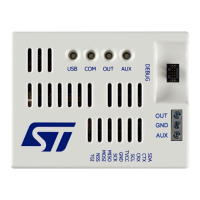7.4.1 Target voltage connection (T_VCC)
The target voltage (T_VCC) must always be provided from the target application (I/Os voltage reference) to
STLINK-V3PWR when the debug interface and bridge functionalities are used.
When connecting the DEBUG connector (using the
STDC14 ribbon) to the target application, it must be provided
to pin 3 of the DEBUG connector (refer to Section 9.3 DEBUG (STM32 JTAG/SWD and VCP)). When using the
BRIDGE functionalities only, without connecting the DEBUG connector to the target, the target voltage must be
provided through the TVCC pin of the BRIDGE connector (refer to Section 9.4 BRIDGE (I
2
C, CAN, SPI, UART,
and GPIO)).
Warning: If target voltage is not provided, the VCP interface, debug interface, trigger, and bridge
functionalities do not work.
Note: T_VCC signal on the DEBUG connector and the TVCC signal on the BRIDGE connector are internally
interconnected.
7.4.2 SWD with SWV
SWD protocol is a debug/program protocol used for STM32 microcontrollers with SWV as a trace. This function is
available on the DEBUG connector
.
For details regarding performance and baud rates, refer to Section 8.5 Debug and bridge performance.
7.4.3 JTAG
JTAG protocol is a debug/program protocol used for STM32 microcontrollers. This function is available on the
DEBUG connector
.
For details regarding performance, refer to Section 8.5 Debug and bridge performance.
7.4.4 Virtual COM port (VCP)
The serial interface VCP (UART) is directly available as a Virtual COM port of the PC, connected to the STLINK-
V3PWR USB connector
. This function is available on both DEBUG and BRIDGE connectors and must be used
exclusively on one or the other connector (UART signals are internally connected).
On the DEBUG connector, the functionality is available without flow control, T_VCP_RX (or RX) signal is the Rx
for the target (Tx for STLINK-V3PWR), T_VCP_TX (or TX) signal is the Tx for the target (Rx for STLINK-V3PWR).
On the BRIDGE connector, the functionality is available with or without hardware flow control (CTS/RTS). On the
BRIDGE connector TXD signal is the Rx for the target (Tx for STLINK-V3PWR), the RXD signal is the Tx for
the target (Rx for STLINK-V3PWR), the CTS signal is the RTS for the target (CTS for STLINK-V3PWR) and the
RTS signal is the CTS for the target (RTS for STLINK-V3PWR). The hardware flow control might be activated
by physically connecting UART_RTS and/or UART_CTS signals to the target. If not connected, the virtual COM
port works without hardware flow control. Note that the hardware flow control activation/deactivation cannot be
configured by software from the host side on a Virtual COM port. Consequently configuring a parameter related to
that on the host application does not affect the system behavior.
To reach a high UART frequency, it is recommended to use a flat ribbon on the DEBUG connector with all unused
signals tied to the ground on the target side.
For details regarding baud rates and performance, refer to Section 8.5 Debug and bridge performance.
7.4.5 Baud rate computing
Some interfaces (VCP and SWV) are using the UART protocol. In that case, the baud rate of STLINK-V3PWR
must be aligned as much as possible with the target one.
Below is a rule allowing the computation of the baud rates achievable by the
STLINK-V3PWR probe:
192 MHz/prescaler with prescaler = [24 to 31] then 96 MHz/prescaler with prescaler = [16 to 65535]
Note: The UART protocol does not guarantee data delivery (all the more without hardware flow control). Consequently,
at high frequencies, the baud rate is not the only parameter impacting the data integrity. The line load rate and
the capability of the receiver to process all the data also affect communication.
UM3097
Debugger interfaces (SWD/JTAG/VCP)
UM3097 - Rev 1
page 15/30

